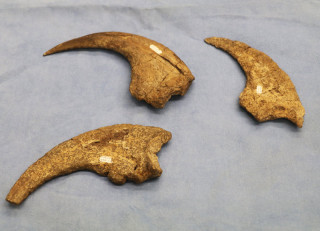Explorer Corps Marker: Kane County
Find the Marker
The Kane County marker is outside of the Kanab Convention Center at 20 N 100 E in Kanab. It highlights the red rock cliffs of Glen Canyon, which is about one hour east.
GPS 37°2’54.168”N 112°31’33.168”W
Dig Deeper
It’s difficult to think of a stranger dinosaur than Nothronychus graffami. This 14-foot-long herbivore walked on two legs, had long neck tipped with a tiny head, bore huge claws on each hand, and had an expansive gut for fermenting vegetation. The dinosaur was more or less the Cretaceous equivalent of a giant sloth, and it was first uncovered near Glen Canyon National Recreation Area.

Within the dinosaur family tree, Nothronychus is a therizinosaur. These dinosaurs were first found in Asia, including species that rivaled Tyrannosaurus in size. They immediately stood out because they belong to the same part of the dinosaur family tree as many carnivorous species, yet the anatomy of their bodies indicated that therizinosaurs were herbivores. But then therizinosaurs started to turn up in North America, and more specifically Utah. One of the most primitive therizinosaurs, Falcarius utahensis, was found in the eastern part of the state, and then Nothronychus mckinkleyi was uncovered in northern New Mexico.
Paleontologists weren’t expecting to find another Nothronychus species. But in 2000, Big Water resident Merle Graffam stumbled across the bones of a dinosaur in a rock formation called the Tropic Shale. This was a marine environment, indicating that the body of the dinosaur had been washed out to see before being buried. Upon study, the bones turned out to be a new species of Nothronychus – named in Graffam’s honor – and was studied by then-University of Utah paleontology graduate student Lindsay Zanno.
The landscape that Nothronychus graffami was discovered in is certainly harsh. In fact, the area was used as the setting for the Forbidden Zone in 1968’s Planet of the Apes. But during the time of Nothronychus, around 95 million years ago, the area was underwater. During this part of the Cretaceous, North America was split in two by the a shallow body of saltwater called the Western Interior Seaway. Huge fish, marine reptiles, and coil-shelled squid cousins called ammonites thrived here, and it was in this setting that at least one Nothronychus was buried.
The time period when Nothronychus was tottering around, pulling branches down to munch, was a critical one for dinosaurs. This was a time just before tyrannosaurs started to get big, when horned dinosaurs started to become more important parts of the ecosystem, and when what paleontologists think of as Late Cretaceous dinosaur communities started to come together.
And there’s certainly more to find. Paleontologists have already excavated the remains of a plesiosaur – or a long-necked, four-paddled marine reptile – from the area where Nothronychus was found. On top of that, paleontologists may have already located another dinosaur site. As paleontologists keep looking into this particular window into the past, the more they’ll see.
Want to Go Farther?
Glen Canyon offers a wealth of opportunities for boating, camping, and other recreation.